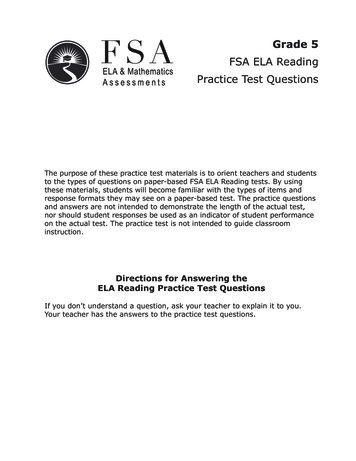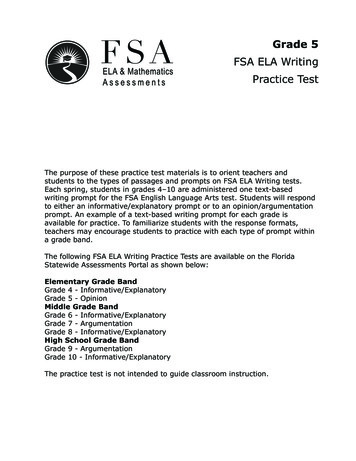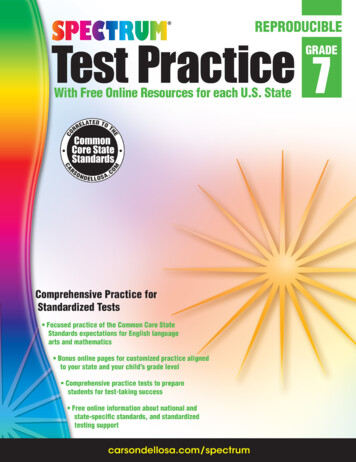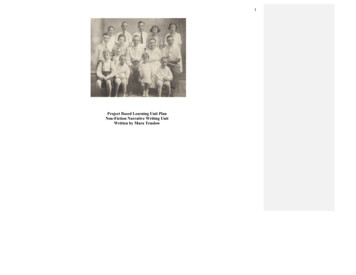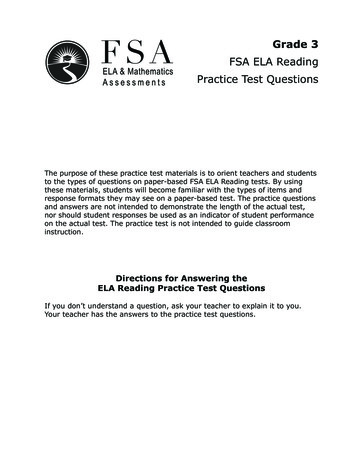
Transcription
Grade 3FSA ELA ReadingPractice Test QuestionsThe purpose of these practice test materials is to orient teachers and studentsto the types of questions on paper-based FSA ELA Reading tests. By usingthese materials, students will become familiar with the types of items andresponse formats they may see on a paper-based test. The practice questionsand answers are not intended to demonstrate the length of the actual test,nor should student responses be used as an indicator of student performanceon the actual test. The practice test is not intended to guide classroominstruction.Directions for Answering theELA Reading Practice Test QuestionsIf you don’t understand a question, ask your teacher to explain it to you.Your teacher has the answers to the practice test questions.
To offer students a variety of texts on the FSA ELA Reading tests, authenticand copyrighted stories, poems, and articles appear as they were originallypublished, as requested by the publisher and/or author. While thesereal-world examples do not always adhere to strict style conventions and/orgrammar rules, inconsistencies among passages should not detract fromstudents’ ability to understand and answer questions about the texts.All trademarks and trade names found in this publication are the propertyof their respective owners and are not associated with the publishers of thispublication.Every effort has been made to trace the ownership of all copyrightedmaterial and to secure the necessary permissions to reprint selections.Some items are reproduced with permission from Cambium Assessment,Inc., as copyright holder or under license from third parties.Page 2
BLANK PAGEPage 3
FSA ELA Reading Practice Test QuestionsRead the passages “The Kettle That Would Not Walk” and “TheCheeses That Ran Away” and then answer Numbers 1 through 4.Passage 1: The Kettle That Would Not Walkby Clifton Johnson1ONE day a man was getting ready to go to market, and his wifesaid to him, “Husband, we need a new iron kettle for the fireplace.Don’t fail to buy one.”2So the man bought a kettle at Nottingham and started for home.But the kettle was heavy, and his arm grew tired with carrying it andhe set it down. While he was resting, he noticed that the kettle hadthree legs. “What a pity I did not see those legs before!” cried the man.“Here you have three legs and I have but two, and yet I have beencarrying you. ‘Twere fairer [It seems more fair] that you had carriedme. Well, you shall take me the rest of the way, at least.”3Then he seated himself in the kettle and said, “Now, go on,” but thekettle stood still and would not move.4“Ah!” said the man, “you are stubborn, are you? You want me tokeep on carrying you, but I shall not. I will tell you the way and youcan stay where you are until you get ready to follow me.”5So he told the kettle where he lived and how to get there, and offthe man went. When he reached home, his wife asked him where thekettle was.6“Oh, it will be along,” he replied.7“What do you mean by that?” said she.8“Why,” said he, “the kettle I bought has three legs and was betterable to walk here than I who have but two legs. Yet I never noticed ithad legs until I was nearly here. Then I told it to walk the rest of theway itself, for I would carry it no farther.”910“Where did you leave it?” asked the wife.“You need not be anxious,” responded the man. “I told it the way,and it will be along in good time, as I said before.”11“And where did you leave it?” again asked the wife.12“At Gotham bridge,” he replied.Page 4Go On
FSA ELA Reading Practice Test Questions13She was not as sure as he was about its coming, and she hurriedoff to get it. When she brought it home, the man said, “I am glad youhave it safe, Wife. I have been thinking while you were gone that itmight have taken a notion to walk back to Nottingham if we had left italone there in the road much longer.”“The Kettle That Would Not Walk” by Clifton Johnson. In the public domain.Passage 2: The Cheeses That Ran Awayby Clifton Johnson14THERE was a man of Gotham who filled a sack with cheeses andstarted off for Nottingham market to sell them. He carried the sack onhis back, and when he became tired he sat down by the wayside torest. Thus he went on until he reached the summit of the last hill hehad to climb before he came to Nottingham bridge.15There he rested, and when he rose to continue his journey a cheeseslipped out of the sack and rolled down the hill toward the bridge.16“Ah! Mr. Cheese,” said the man, “so you can run to market alone,can you? I wish I had known that before. It would have saved me thetrouble of carrying you. Well, then, if you can go to market alone, socan the other cheeses, and I will send them along after you.”17So he laid down his sack, took out the cheeses, and one by onerolled them down the hill. As the last one spun down the road heshouted, “I charge you all to meet me at the market-place.”18Some of the cheeses went into one bush, and some went intoanother bush, but the man did not notice that, and he trudged oncheerfully to the market expecting the cheeses would meet him there.All day long he loitered about the market, and as evening approachedhe began to inquire among his friends and neighbors and other men ifthey had seen his cheeses come to the market.19“Who should bring them?” asked one of the market-men.20“Nobody,” replied the man of Gotham. “They would bringthemselves. They know the way well enough.”“The Cheeses That Ran Away” by Clifton Johnson. In the public domain.1006Page 5Go On
FSA ELA Reading Practice Test QuestionsNow answer Numbers 1 through 4. Base your answers on thepassages “The Kettle That Would Not Walk” and “The Cheeses ThatRan Away.”1. What is the meaning of anxious as it is used in Passage 1?“You need not be anxious,” responded the man. “I told it the way,10and it will be along in good time, as I said before.”A angryB excitedC sadD worried14922Page 6Go On
FSA ELA Reading Practice Test Questions2. Fill in the bubble before one sentence from Passage 2 that shows whythe man believes that his cheeses can bring themselves to the market.14A THERE was a man of Gotham who filled a sack with cheeses andstarted off for Nottingham market to sell them. B He carried the sackon his back, and when he became tired he sat down by the wayside torest. C Thus he went on until he reached the summit of the last hill hehad to climb before he came to Nottingham bridge.15D There he rested, and when he rose to continue his journey acheese slipped out of the sack and rolled down the hill toward thebridge.149173. What does paragraph 16 add to Passage 2?A It tells where the story takes place.B It tells information about the main character’s past.C It shows the lesson that can be learned from the story.D It shows the beginning of the main character’s problem.14946Page 7Go On
FSA ELA Reading Practice Test Questions4. This question has two parts. First, answer Part A. Then, answer Part B.Part AWhich sentence describes the man’s feelings at the end of Passage 2?A He is pleased with his decision.B He is excited to be traveling for his work.C He is angry that he has to go to the market.D He is unhappy about his choices in the story.Part BWhat happens in the passage because of the man’s feelings in Part A?A The man has nothing to sell at the market.B The man arrives at the market well-rested.C The man’s cheeses get to the market on time.D The man’s cheeses become famous in the town.14945Page 8Go On
GO ONTO THENEXT PAGE.Page 9Go On
FSA ELA Reading Practice Test QuestionsRead the passage and then answer Numbers 5 through 7. There arethree underlined words or phrases in the passage to show whichword or phrase may be incorrect. 1012Tomorrow was the spelling bee. Sam was nervous, so he asked his mom tohelp him practice. If he worked hard, he knew he could learn all of the words.After school, Sam and his mom began to practice spelling. Sam frowningwhen he heard the first word: “muscle.” He tried to sound it out. He carefullywrote down “mussel.” His mom smiled but shook her head. Sam had gottenit wrong.His mom explained the error, but Sam was upset. He didn’t want to practiceanymore. But then his mom did something strange. She made a silly, funnyface. Sam was surprised, and we started to laugh.Page 10Go On
FSA ELA Reading Practice Test QuestionsNow answer Numbers 5 through 7. Choose the correct word orphrase for each of the following.5. If he worked hard, he knew hecould learn all of the words.7. Sam was surprised, and westarted to laugh.A word’sA sheB words’B heC wordesC ID correct as is14842D correct as is148446. Sam frowning when he heardthe first word: “muscle.”A frownB frownedC frownsD correct as isPage 1114843Go On
FSA ELA Reading Practice Test QuestionsRead the passages “A Raft of Ants” and “Insect Farmers” and thenanswer Numbers 8 through 15.Passage 1: A Raft of Antsby Dan Risch1Fire ants live deep underground. But what happens when heavy rainsflood their cozy homes? The fiery red insects go marching out of the nestand onto the water. There, they make a raft of their own bodies.2Floating on the surface, the first ants that come out build the raft.A layer of ants spreads across the water. They hold on to one another,using their claws and jaws and sticky feet.3What a tangle of ants! But it’s just what the ants need to save theircolony from drowning. As the ants weave themselves together, theydon’t even get their antennae wet.4Once the raft is in place, one by one and two by two, more antsmarch out of the nest and onto the ant raft. They carry ant eggs, antbabies, and, of course, the queen. (Some ants may even pack a bit offood for the trip.)5Up and out the ants march until the entire nest of ants is on theraft. An average-sized nest is made up of 100,000 fire ants.6The floodwaters carry the raft away. Every once in a while, thebottom ants change places with the ants on top. Finally, the rafttouches higher ground, where the colony can make a new nest. Theants have survived by sharing all of the work. Now that’s teamwork!7One ant uses its jaws to hold on to another ant’s leg.8They use claws and jaws and sticky feet!Page 12Go On
FSA ELA Reading Practice Test QuestionsExcerpt from "A Raft of Ants" by Dan Risch. Copyright 2013 Highlights for Children, Inc., Columbus,Ohio. All rights reserved. Used by permission. Photograph copyright David Hu and Nathan J. Mlot,Georgia Institute of Technology.Passage 2: Insect Farmersby Paula Cushing9The farmer stepped back and surveyed her garden. It looked fineand healthy. A little more fertilizer here and there and her day’s workwould be done.10Her sisters were busy in another part of the garden gathering someof the crop to feed to the youngsters. Yes, nothing beats a good gardenof young mushrooms.You see, this is no ordinary farmer. She is a leaf-cutting ant.1112I first saw leaf-cutting ants on a six-month visit to Panama. I hadplenty of time to watch the ants because I lived and worked at a tropicalresearch station on Barro Colorado Island in the Panama Canal area.13Barro Colorado became a biological reserve in 1923. Since thenscientists from all over the world have gone there to study tropicalplants and animals.Page 13Go On
FSA ELA Reading Practice Test QuestionsJungle Walks14There are no roads on the island, just nature trails cutting through thejungle. Nearly every time I walked out on the trails, I had to step over amarching column of leaf-cutting ants—they seemed to be everywhere!15At first, the marching columns looked like little pieces of leavesmoving by themselves. But when I looked more closely, I saw thateach piece of leaf was being carried by a reddish ant many timessmaller than the leaf. The ants had cut the leaves with their scissorlikejaws and were carrying them back to their nests.16Leaf cutters don’t eat the leaves. Rather, they use the leaves toraise their most important food, which is a particular kind of fungus.The ants take the leaves to special rooms in their underground nests.They cut the leaves into smaller pieces, chew the pieces until they arewet and spongy, and deposit them in their garden.17Then the ants transplant some fungus onto their fresh “leaf-soil.”Sometimes they add fertilizer that they excrete from their abdomens.18Adult ants feed on this fungus as well as on sap. The fungus is alsoeaten by the larvae, which are the baby ants.19The fungus they grow is a type of mushroom. But the ants havebeen farming it for so long that it doesn’t grow into anything that lookslike regular mushrooms. Instead, it looks more like a mass of tinydouble-headed lollipops.Ants, Big and Small20A leaf-cutter colony is made up of ants of different sizes. Large antsgo out and gather the leaves. Smaller ants guard the big ants, cut upthe leaves, tend the garden, and care for the eggs and larvae.21The biggest ant is the queen. Her main job is to lay eggs. All of theother ants in the colony are her daughters. They have many jobs,which they do by instinct, communicating with one another and theirqueen when necessary.22Of course, ants can’t talk the way we can. Instead, the antscommunicate through a chemical language. They pass around theirchemical messages when they feed one another. Workers pass dropletsof food to other workers (their sisters). They also feed larvae. Larvaesometimes feed their nurses. The queen feeds her daughters. AndPage 14Go On
FSA ELA Reading Practice Test Questionsworkers feed their mom, the queen. An ant colony’s chemicalcommunication network is more complicated than our telephone lines."Insect Farmers" by Paula Cushing. Copyright 1998 Highlights for Children, Inc., Columbus, Ohio. Allrights reserved. Used by permission.999Page 15Go On
FSA ELA Reading Practice Test QuestionsNow answer Numbers 8 through 15. Base your answers on thepassages “A Raft of Ants” and “Insect Farmers.”8. What does the word weave mean as it is used in this sentence fromPassage 1?“As the ants weave themselves together, they don’t even get theirantennae wet.” (paragraph 3)A crowdB floatC gatherD join148209. Fill in one bubble in each row to show the order of steps ants take toleave their homes during a flood in Passage 1.FirstNextFinallyThey build a new nest.ABCThey move food and each other.DEFThey stick their bodies together.GHI14817Page 16Go On
FSA ELA Reading Practice Test Questions10. This question has two parts. First, answer Part A. Then, answer Part B.Part ABased on the information in Passage 1, with which statement would theauthor agree?A Rafts are too small to fit all of the ants from a colony.B Smaller colonies may not live through a flood.C The ants may not survive the journey without food.D Building a raft is a clever way for the ants to survive.Part BWhich piece of evidence from Passage 1 supports your answer in Part A?A“What a tangle of ants! But it’s just what the ants need to save theircolony from drowning.” (paragraph 3)B“Once the raft is in place, one by one and two by two, more antsmarch out of the nest and onto the ant raft.” (paragraph 4)C“They carry ant eggs, ant babies, and, of course, the queen. (Someants may even pack a bit of food for the trip.)” (paragraph 4)D“An average-sized nest is made up of 100,000 fire ants.” (paragraph 5)14822Page 17Go On
FSA ELA Reading Practice Test Questions11. What does the reader understand using the information from Passage 1and the illustration?A how large an ant raft can beB how many eggs can fit on the raftC how the ant raft floats on top of the waterD how many ants are needed to make a raft1482312. What is the main idea of Passage 2?A Leaf-cutting ants grow mushrooms using leaves as soil.B Leaf-cutting ants work together to grow food for the entire colony.C Leaf-cutting ants have scissorlike jaws that are used to cut leaves.D Leaf-cutting ants have a queen who is the biggest ant in the colony.14818Page 18Go On
FSA ELA Reading Practice Test Questions13. Which information can be found under the heading Jungle Walks inPassage 2?A why the ants gather leavesB when the author first visited PanamaC how the ants communicate with the queenD where the Barro Colorado reserve can be found1482114. Select two reasons the author included paragraph 11 in Passage 2.A to compare leaf-cutting ants to human farmersB to describe how leaf-cutting ants grow their foodC to explain how leaf-cutting ants solve farming problemsD to show that the topic of the passage is leaf-cutting antsE to describe the effect that leaf-cutting ants have on ordinary farms15051Page 19Go On
FSA ELA Reading Practice Test Questions15. How are Passages 1 and 2 alike?A They describe how ants communicate.B They describe how ants work as a team.C They describe why ants have sticky feet.D They describe why ants carry large leaves.14825Page 20Go On
GO ONTO THENEXT PAGE.Page 21Go On
FSA ELA Reading Practice Test QuestionsRead the passage and then answer Numbers 16 through 18. Thereare three underlined words or phrases in the passage to show whichword or phrase may be incorrect. 1064161718Picture a bear in a fuzzy, warm sweater. Imagine a squirrel that worn apair of thick socks. Silly, right? How do animals live in very cold places?Some animals have thick fur coats to keep them warm. Others burythemselves in cozy little holes. What scientists don’t know is whetheranimals feel cold in the same way that humans do. They were curios tolearn more.One scientist made a test. She set up two paths for squirrels to choosebetween. The first path was warm than the second path. In fact, thesecond path was freezing cold! She found that the squirrels moved alongboth paths but seemed to like the first path best. The scientist believesthat animals do feel the cold, but they may not feel it as much ashumans do.Page 22Go On
FSA ELA Reading Practice Test QuestionsNow answer Numbers 16 through 18. Choose the correct word orphrase for each of the following.16. Choose the correct verb.18. Choose the correct adjective.A wearA warmerB wearsB warmestC wearingC most warmD correct as is1531217. Choose the correct spelling.A curiusB curousC curiousD correct as isPage 2315313D correct as is15314
Office of AssessmentFlorida Department of Education, Tallahassee, FloridaCopyright 2020 State of Florida, Department of State
A THERE was a man of Gotham who filled a sack with cheeses and started off for Nottingham market to sell them. B He carried the sack on his back, and when he became tired he sat down by the wayside to rest. C Thus he went on until he reached the summit of the last
